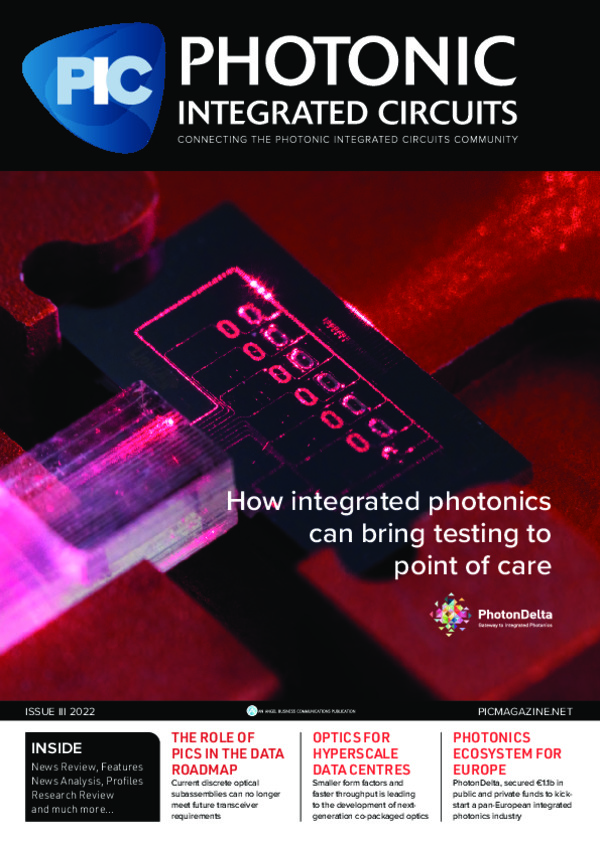
How a hybrid integration platform for co-packaged photonics solves many of the chip industry’s problems

When industry leaders gathered in San Diego for the 2022 Optical Fiber Communication Conference, several of them reacted with amazement and even disbelief when they witnessed demonstrations of the POET Optical Interposer. What impressed the industry in March, and in the months since, is the elegance of the engineering that has led to the development of the innovation’s differentiating features.
BY POET Technologies
The unique hybrid integration platform of the Poet Optical Interposer uses a CMOS-based Optical Interposer for wafer-scale passive assembly of electronics and photonics devices. It does it with a minuscule form factor and a reduction of the bill of materials that represents a drop in assembly costs from as much as 70% of total cost to less than 20%.
The versatile platform includes all the features necessary for high-speed datacenter applications: excellent RF performance, low loss, athermal and non-birefringent waveguides and low loss chip-to-fiber coupling, passive placement of optical devices, excellent thermal properties with low thermal resistance, and low-cost wafer-scale assembly and test. Products based on the Optical Interposer show excellent performance for 100G, 200G and 400G applications, and are readily scalable to 800G and 1.6T pluggables.
The development of the underlying technology and products based on the Optical Interposer was completed in about five years by the POET team in consultation with executive leaders in semiconductors, telecommunications, optoelectronics and datacenter management.
POET Technologies has built a proprietary Optical Interposer that impressively reduces cost and the bill of materials.
With the desire for faster, more reliable transfer of data to satisfy our hyperconnected world, the networking industry has been stressed to meet the demand. Delivering dependable service with conventional technology has been a challenge. A need for a better solution exists and results indicate the Optical Interposer is in the lead to meet that challenge.
POET Technologies’ Optical Interposer sandwiches optical layers between
two electrical layers to create next-generation chip solutions.
The Optical Interposer’s distinct features
The Optical Interposer is constructed using CMOS-compatible wafer fabrication methods using a high-resistivity silicon substrate to enable high-speed RF communications. Electrical traces required for electronic component interconnectivity are first formed on the silicon substrate. Integrated heat sinks are incorporated under the metal and in regions of the interposer that house the lasers, enabling a low thermal resistance for the lasers, which is critical to ensure laser functionality in uncooled applications.
Thereafter, multiple waveguide layers are monolithically deposited on the wafer. These waveguides are configured to perform the various passive optical functions required such as multiplexers, de-multiplexers, vertical and in-plane couplers, interferometers and directional coupler-based power taps. The Optical Interposer is then finished with low-loss vertical coupling mirrors for out-of-plane optical connections and with mirror-like etched facets for in-plane coupling of lasers and fiber connections.
Self-referencing pedestals, fiducial marks and mechanical guides enable visually assisted passive placement of the optical devices integrated on the platform. Finally, eutectic solder is deposited on the interposer to promote flip-chip bonding of the optical and electrical components that are subsequently assembled on the platform.
Along with the passive alignment of lasers for flip-chip bonding, the approach enables straightforward integration of photonic elements such as detectors. Here are details of the primary components within the Optical Interposer that help it to bring novel solutions to market.
Waveguides: POET’s waveguides are designed to both be CMOS compatible and provide low-loss characteristics. The material loss through the waveguides characterized by prism spectroscopy is less than 0.3dB/cm and is about one order of magnitude better than typically observed in small core silicon waveguides used in most other silicon photonics technologies. Moreover, the waveguides are largely athermal (dn/dT=12pm/°C) and are non-birefringent. A proprietary spot-size converter has been designed for chip facet fiber coupling and it achieves facet coupling losses of 0.25dB.
The addition of these patented waveguide layers on a conventional semiconductor wafer is critical to enabling the integration of electronics and photonics components at wafer scale.
The miniature form factor of the Optical Interposer makes POET’s device attractive for manufacturers.
Optical passive device performance: Waveguides must be designed and configured into high-performance optical passive devices for use in any optical application. Multiplexers and demultiplexers form the backbone of any direct detect data-communications wavelength division multiplexing (WDM) system. These devices have to be precisely engineered for the required bandwidth spectrum used (for example, FR4 or LR4). The measured optical spectrum for the passive demux/mux devices built on the Optical Interposer for FR4 and LR4 systems offer excellent insertion loss, crosstalk and channel uniformity. These are achieved while exceeding industry requirements.
Vertical Mirrors: In addition to in-plane coupling of light, POET’s Optical Interposer utilizes vertical mirrors to enable out-of-plane coupling. The vertical mirrors are used with top-entry photodetectors and for wafer-level testing. When coupled to a PD, the vertical mirrors deliver a 0.5dB coupling loss, an outstanding result compared to competing solutions.
Thermal Performance: Achieving low thermal resistance is a critical requirement for hybrid integration. The Optical Interposer has consistently shown that it can achieve equivalent thermal resistances to conventional P-up lasers, which are mounted on a standard AlN submount. With the Optical Interposer, a P-down laser is attached to attain a comparable thermal path from the heat source (laser) to the back of the device through the integrated heat sink.
Laser Coupling: One of the key benefits to using the Optical Interposer is its visually assisted wafer-scale passive placement of optical devices such as lasers while simultaneously achieving good coupling efficiency to the waveguides. The coupling performance for CW lasers with integrated spot-size converters is best in class for such passive alignment techniques. A coupling efficiency of 90% (1dB) has been achieved using the Optical Interposer.
Product Demonstration: The features of the Optical Interposer have been used along with compatible optical components to create the world’s smallest single-chip optical engine for 100G and 200G applications. At 6mm x 9mm, the POET optical engine incorporates four lasers, four high-speed photodetectors, four monitor photo diodes and a multiplexer/de-multiplexer pair.
The waveguides are key to the lasers within the Optical Interposer, which can include inexpensive DMLs.
The optical engine is so small, that a transceiver module manufacturer can fit four such engines inside a standard QSFP-DD module, thus quadrupling data rates for a given faceplate density. The Optical Interposer also achieves excellent eye margins, and 100G and 200G receivers built using this technology have demonstrated outstanding characteristics, meeting 10km LR4 system requirements based on BER/sensitivity performance.
With clear advantages in cost and scale, it is little wonder that the tiny Optical Interposer has garnered significant interest from the optoelectronics community and beyond. Among the interesting partnering opportunities that have emerged are those with innovative device companies that are seeking to utilize POET’s platform to usher in a new era of optical engines for transceivers and co-packaging applications. POET has partnered with Celestial AI, a Silicon Valley-based developer of artificial intelligence and machine learning solutions, and is preparing to deliver samples of a packaged light source assembly for AI-ML accelerator chips.
In addition, the POET team has had dozens of conversations with heads of leading companies in a variety of industries since its live product demonstrations at the OFC Conference. With engineering teams in Singapore and two locations in China (Shenzhen and at the joint venture, Super Photonics, in Xiamen), POET is able to work with partners to customize solutions and maximize the capabilities of its platform technology. In June, POET became a founding partner of the Singapore Hybrid-Integrated Next Generation µ-Electronics (SHINE) Centre, located in the College of Design and Engineering at the National University of Singapore (NUS), where research and development teams will work to unlock hybrid-integration solutions for the industry. POET’s participation as a founding member gives it access to a variety of advanced packaging tools and engineers, as well as opportunities to showcase its technology and collaborate with a global industrial and academic network of companies and universities.
The POET Optical Interposer is an elegant solution that is scheduled for commercial deployment in 100G, 200G and 400G applications.
The current and future solutions built from the Optical Interposer are poised to drive the next generation of microelectronics engineering, beginning with an exciting fall when the first commercial products using the device enter production at Super Photonics, which benefits from Xiamen Sanan Integrated Circuit’s world-class facility and a growing engineering team. Because it is an integration platform that is agnostic to the material system, the Optical Interposer provides great flexibility to engineers and manufacturers, allowing it to penetrate multiple markets. This distinctive feature means that POET can address applications where conventional free-space optics or traditional silicon photonics cannot. The pieces are in place for POET to deliver on the promise of the Optical Interposer and the industry has taken notice.
Assembly of products that feature the POET Optical Interposer takes place at a state-of-the-art facility in Xiamen, China.
As one executive of a peer company at OFC 2022 marveled when seeing the form factor of the Optical Interposer: “Well, you can’t get much smaller than this.” You can’t — and that innovation of saving space without sacrificing performance is why the platform is such a big deal.



































